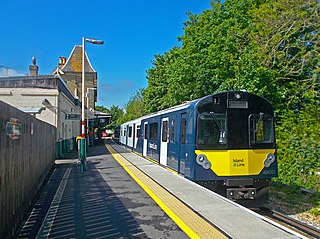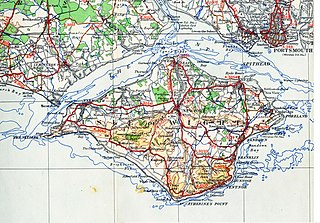
The Isle of Wight is an island, English county and unitary authority in the English Channel, 2 to 5 miles off the coast of Hampshire, across the Solent. It is the largest and second-most populous island in England. Referred to as "The Island" by residents, the Isle of Wight has resorts that have been popular holiday destinations since Victorian times. It is known for its mild climate, coastal scenery, and verdant landscape of fields, downland, and chines. The island is historically part of Hampshire. The island is designated a UNESCO Biosphere Reserve.

Newport is the county town of the Isle of Wight, an island county off the south coast of England. The town is slightly north of the centre of the island, and is in the civil parish of Newport and Carisbrooke. It has a quay at the head of the navigable section of the River Medina, which flows northwards to Cowes and the Solent. The 2021 census recorded a population of 25,407.

The Island Line is a railway line on the Isle of Wight which runs along the island's east coast and links Ryde Pier Head with Shanklin. Trains connect at Ryde Pier Head with passenger ferries to Portsmouth Harbour, and these ferries in turn connect with the rest of the National Rail network via the Portsmouth Direct Line. The line also connects to the Isle of Wight Steam Railway, a heritage railway, at Smallbrook Junction. For much of its length the line runs alongside the A3055, criss-crossing this road by means of the Ryde Tunnel and bridges at Rowborough, Morton Common, Lake Hill and Littlestairs.
Education on the Isle of Wight is provided by local education authority-maintained schools on the Isle of Wight, and independent schools. As a rural community, many of these schools are small, with average numbers of pupils lower than in many urban areas. It was decided on 19 March 2008, in a Whole Council Meeting, that the three-tier system would change into a two tier system. A report into the report on the re-organisation with proposals as to which schools would close was published in May 2008. There is also a college on the Isle of Wight and other less formal educational venues.

The Isle of Wight Railway was a railway company on the Isle of Wight, United Kingdom; it operated 14 miles of railway line between Ryde and Ventnor. It opened the first section of line from Ryde to Sandown in 1864, later extending to Ventnor in 1866. The Ryde station was at St Johns Road, some distance from the pier where the majority of travellers arrived. A tramway operated on the pier itself, and a street-running tramway later operated from the Pier to St Johns Road. It was not until 1880 that two mainland railways companies jointly extended the railway line to the Pier Head, and IoWR trains ran through, improving the journey arrangements.

Blackwater is a village on the Isle of Wight, England. It is located about two miles south of Newport, close to the geographic centre of the island. It is in the civil parish of Arreton. The Newclose County Cricket Ground is just to the north of the village.

Rookley is a village and civil parish on the Isle of Wight. It is located five kilometres south of Newport near the centre of the island.

Southern Vectis is a bus operator on the Isle of Wight. The company was founded in 1921 as "Dodson and Campbell" and became the "Vectis Bus Company" in 1923. The company was purchased by the Southern Railway before being nationalised in 1969. In 1987, the company was re-privatised. In July 2005, it became a subsidiary of Go-Ahead Group.

Lake is a large village and civil parish located on Sandown Bay, on the Isle of Wight, England. It is six miles south-east of Newport situated between Sandown and Shanklin, and 1+1⁄2 miles (2.4 km) to the east of the hamlet of Apse Heath.

Chillerton is a village between Newport and Chale in the Isle of Wight in southern England. Chillerton is in the middle of a farming community. It is in the civil parish of Chillerton and Gatcombe, along with nearby Gatcombe; the parish had a total population of 422 at the 2011 census.
Medina College is a foundation secondary school in Newport on the Isle of Wight, formerly Medina High School.

Wightbus was a bus operator on the Isle of Wight, established and owned by the Isle of Wight County Council. It operated a network of thirteen local bus services running across the island, mostly services which would not have been viable for the island's dominant commercial operator, Southern Vectis, to operate.

There are several modes of Transport on the Isle of Wight, an island in the English Channel.
Sandown Bay Academy, formerly Sandown High School, was an academy status secondary school located in Sandown on the Isle of Wight, England. From 2012 to 31 August 2018 it was sponsored by the Academies Enterprise Trust. On 31 August 2018, the academy closed.

Isle of Wight Fire and Rescue Service was the statutory fire and rescue service covering the Isle of Wight off the south coast of England. On 1 April 2021, it merged with Hampshire Fire and Rescue Service to form Hampshire & Isle of Wight Fire and Rescue Service (HIWFRS).

There once existed a 55+1⁄2-mile (89.3 km) network of railway lines on the Isle of Wight, which operated both as a self-contained railway network, and as links to ferry services between the island and the South coast of Great Britain. The routes were opened by several companies between 1862 and 1901 and modernised after The Grouping in the 1920s. Most of them were permanently closed between 1952 and 1966, whilst the 8+1⁄2-mile-long (13.7 km) Island Line was temporarily closed in 1966 and rebuilt for electric train services, introduced in 1967. Replacement trains were introduced in 1990, and again in 2021 along with a major renewal of the line. A further 5+1⁄2 miles (8.9 km) have reopened as a heritage line known as the Isle of Wight Steam Railway and there have been several proposals to expand the network further since the 1960s, either with conventional heavy rail or by conversion to light rail.

David Pugh is a former Conservative councillor and served as leader of the Isle of Wight Council between September 2007 and May 2013, making him the longest serving leader of the local authority since its inception in 1995. He was first elected to the Isle of Wight Council at the local elections in May 2005 as a member for the Shanklin Central Ward, re-elected in the June 2009 elections to the Shanklin South Ward, losing his seat in the 2013 local elections after 2 other candidates withdrew, making the election a straight choice between Pugh and Independent, Richard Priest. Consequently, he ceased to be council leader.















